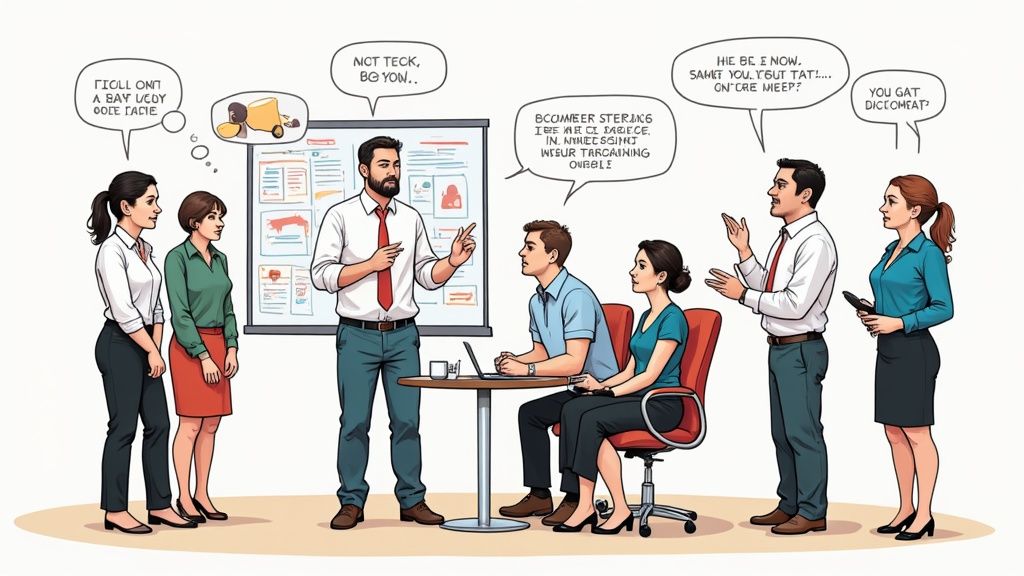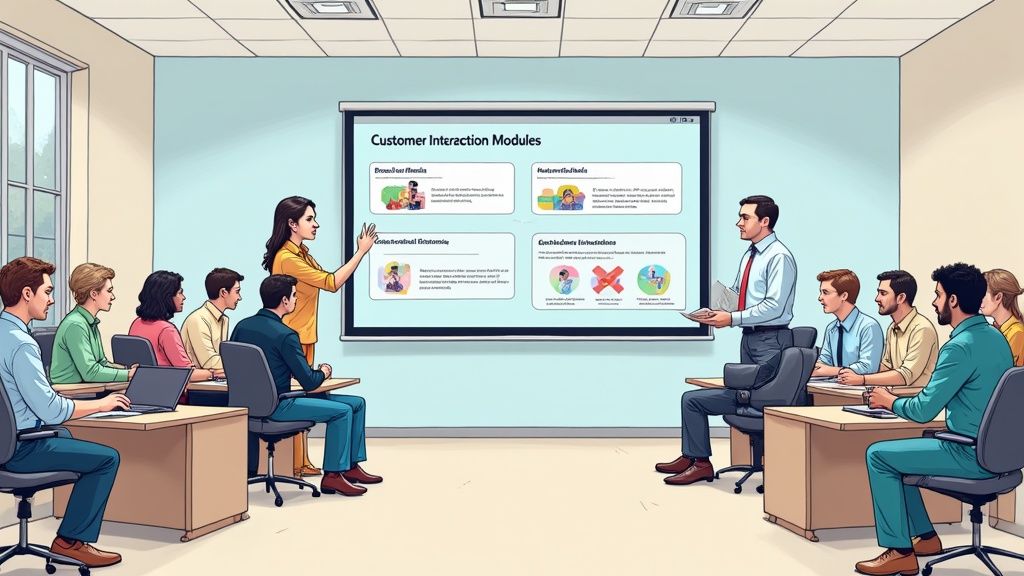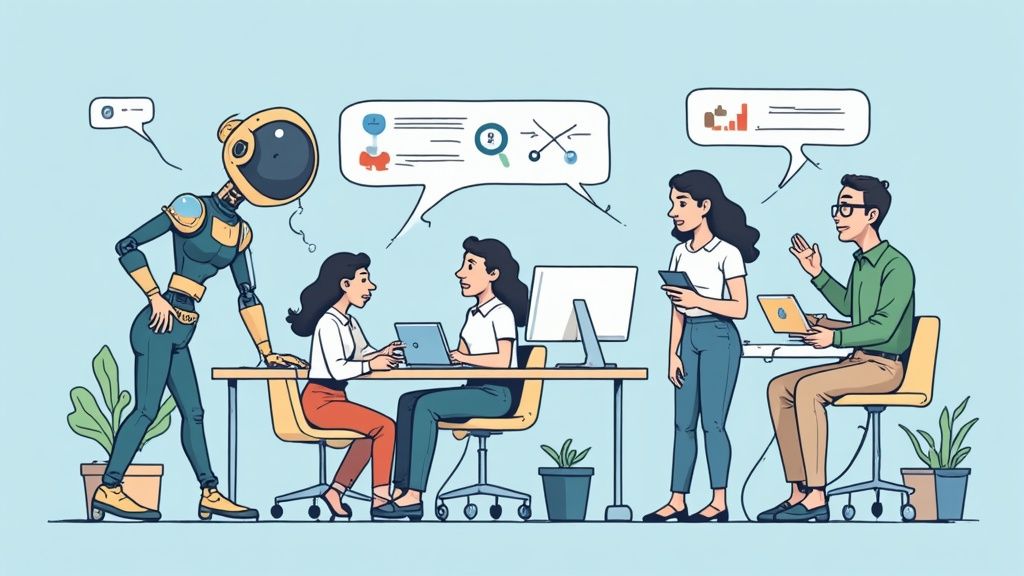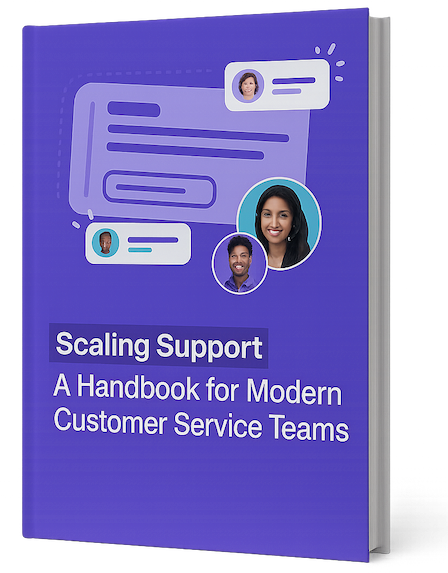Understanding the Real Impact of Service Training

Quality customer service training has become essential for business success. More than just a nice extra, effective training directly affects key business metrics – from customer retention to revenue growth. Understanding exactly how training programs impact your business helps you make smarter investments in your team's development.
Connecting Training and Financial Performance
The numbers tell a clear story about the value of customer service education. Research shows companies that implement structured training programs see tangible results – specifically, a 6.2% boost in revenue and 7.4% increase in customer retention. This happens because well-trained representatives build stronger customer relationships through better service. They solve problems more effectively, identify sales opportunities naturally, and create the kind of experience that keeps customers coming back.
Beyond Traditional Approaches: Why Modern Training Matters
Old-school training methods that relied on scripts and memorization don't cut it anymore. Today's customer service requires thoughtful problem-solving and genuine human connection. Picture a customer calling in frustrated about a technical issue – a well-trained rep doesn't just follow a checklist, but actively listens, shows empathy, and works collaboratively to find a solution. Companies that invest in this kind of comprehensive training see concrete improvements, including a 16% drop in support requests as reps handle issues more effectively the first time.
Measuring the ROI of Customer Service Training Programs
To justify investing in training, you need clear data showing the returns. The key is tracking specific metrics that demonstrate the impact:
| Metric | Impact of Effective Training |
|---|---|
| Revenue Growth | Increased Sales, Upselling |
| Customer Retention Rate | Improved Loyalty, Reduced Churn |
| Customer Lifetime Value | Increased Customer Spending |
| Support Request Reduction | Improved Efficiency, Cost Savings |
| Customer Satisfaction (CSAT) | Enhanced Customer Experience |
These numbers paint a clear picture of training's value. For example, when you see CSAT scores climb after implementing new training, you can directly connect improved customer experience to your program. Similarly, lower support costs show how training helps reps work more efficiently. This concrete data makes it much easier to get buy-in for ongoing training investments that benefit both your team and bottom line.
Building Training Programs That Scale

Today's customer service environment requires support teams that can adapt quickly and handle complex customer needs effectively. This means your training programs must do more than just onboard new hires – they need to continuously develop your existing team's skills while flexibly accommodating growth. Building programs that scale well is essential for keeping service quality high as your team expands.
The Psychology of Effective Learning and Retention
Adult learning works best through active engagement rather than passive absorption. When designing training, focus on methods that get representatives directly involved in the learning process. For instance, role-playing real support scenarios allows reps to practice handling difficult situations in a low-pressure environment. Case studies and group problem-solving exercises help teams develop critical thinking skills they'll use daily. This hands-on approach builds both competence and confidence.
Modern Training Approaches for Modern Support Teams
The most successful programs today embrace ongoing skill development rather than one-time training events. Breaking complex topics into focused mini-lessons makes the material more digestible and easier to fit into busy schedules. Some teams have found success adding game elements like point systems or achievement badges, which boost participation and make learning more enjoyable. The key is keeping the content relevant and immediately applicable to daily work.
Strategies for Creating Programs That Stick
To build training that drives real results, start by defining clear learning goals tied to business objectives. As mentioned earlier, effective training led to a 16% drop in support requests – that's the kind of measurable impact you want. Structure your program as a series of building blocks, with each module reinforcing previous lessons while introducing new skills. This progressive approach helps representatives steadily develop their capabilities over time.
Avoiding Common Pitfalls in Training Program Development
One mistake many teams make is treating training as a "set it and forget it" task. Customer service practices evolve constantly, so your training materials need regular updates to stay relevant. Just as importantly, gather feedback from your representatives about what's working and what isn't. Your frontline team knows firsthand which skills matter most in their daily interactions. Use their input to refine the program and ensure it truly prepares them for success. Making these ongoing improvements helps create a training system that can grow and adapt alongside your team.
Creating Training Content That Transforms Teams

The success of customer service training starts with engaging, relevant content. Rather than using generic presentations, teams need carefully crafted materials that drive real behavioral change. This means getting practical with active learning instead of relying only on lectures and theory.
Designing Engaging and Interactive Training Materials
The most effective training programs blend core concepts with hands-on practice. Take empathy training, for example – instead of just talking about it, have representatives act out challenging customer scenarios to practice showing empathy under pressure. This type of immersive learning helps teams internalize key skills in a low-stakes environment before using them with real customers. Studies show interactive training can increase engagement by 31%, leading to better results.
Addressing Both Fundamental Skills and Complex Support Scenarios
A well-rounded program needs to cover both the basics and advanced topics. This includes foundational elements like communication skills and company policies, as well as nuanced areas like defusing conflicts and managing escalations. By preparing teams for the full range of situations they'll face, from routine questions to tricky complaints, you help them handle any interaction with confidence.
Structuring Training for Optimal Learning and Retention
Think of training like building blocks – start with core concepts before advancing to more complex skills. Breaking topics into focused modules makes the content easier to absorb. For instance, when teaching representatives how to handle upset customers, you might have separate sections on recognizing emotional cues, using calming language, and knowing when to bring in a manager. This step-by-step approach lets teams master each component before putting it all together.
Maintaining Training Quality While Scaling Across Large Teams
As your team grows, keeping training consistent becomes crucial. Set clear learning goals tied to metrics like customer satisfaction and resolution rates. While technology like LMS platforms can help standardize training delivery, don't lose the human element. Regular feedback from your team helps you refine the program and ensure it stays relevant. This ongoing improvement process is key to developing training that truly enhances team performance and creates exceptional customer experiences.
Measuring What Actually Matters in Training

After putting time and effort into developing strong customer service training, you need to know if it's working. The key is focusing on metrics that show real business impact rather than just tracking basic completion numbers.
Connecting CSAT to Training Initiatives
Customer satisfaction (CSAT) scores directly reflect how well your team interacts with customers. For example, if you notice CSAT scores climb after rolling out a training module on empathy and active listening, you can trace that improvement back to the program. To dig deeper, compare CSAT data between newly trained staff and experienced team members. This gives you detailed insights into which training elements work best.
Identifying Key Performance Indicators (KPIs)
While CSAT is crucial, other metrics help paint the full picture of training effectiveness. Key metrics like First Response Time, Resolution Rate, and Customer Churn Rate show how well your programs work. Well-designed training should lead to faster responses and better resolution rates, which help keep customers happy and reduce churn. Make sure to pick KPIs that match your business goals.
Building a Measurement System That Works
Creating an effective measurement system requires three key elements:
- Data Collection: Use tools like surveys, CRM data, and support tickets to gather information. Tools like SurveyMonkey help streamline this process.
- Analysis and Reporting: Review data regularly and create clear visual reports showing trends. For instance, track CSAT scores over time and see how they change after training.
- Feedback Loop: Use performance data to improve training content and delivery methods. This ongoing refinement helps your programs stay effective.
Demonstrating Value to Stakeholders
Use your data to show stakeholders how training directly improves business results. Share reports that connect training to positive outcomes. For example, highlight how support costs dropped 7% after training, as noted in the 2024 Forrester report commissioned by Intellum. When you can prove training's return on investment through clear metrics, you're more likely to get continued support for development programs. This ongoing commitment helps maintain strong customer service quality.
Integrating Training With Business Strategy
Customer service training is much more than just running workshops – it's a key driver of business success. Smart companies see training as an investment that improves important metrics across the organization. This means carefully connecting training programs to core business goals and strategies.
Aligning Training With Business Goals
The first step is making sure training directly supports specific business objectives. For example, if you want to boost customer retention rates, focus training on skills like empathy, active listening, and proactive problem-solving. This targeted approach ensures that training efforts lead to measurable results that matter to the business.
Securing Buy-In and Resources
Getting executive support requires showing clear connections between training and business outcomes. For instance, sharing data like how companies with structured training programs see 7.4% higher customer retention helps make the case for investment. This evidence-based approach demonstrates training's value, especially in key areas like reducing support costs.
Frameworks for Connecting Training and Growth
You can track training impact using frameworks focused on customer satisfaction metrics like CSAT and Net Promoter Score. Monitor how these scores improve after specific training modules to show direct results. Another approach maps training content to customer journey stages, ensuring representatives have the right skills for each interaction.
Building Cross-Departmental Support
Effective training requires cooperation across departments since customer service interacts with sales, marketing, product teams and more. Joint training sessions and feedback loops help build shared understanding of customer needs. For example, including sales teams in service training helps them better address customer concerns during the sales process. This collaboration strengthens the entire customer experience by breaking down silos between teams and creating a customer-focused culture that drives growth.
Optimizing Training for Continuous Improvement
Like any successful business process, customer service training requires ongoing refinement and adaptation. To maintain quality and effectiveness, organizations need clear systems for collecting feedback, analyzing performance data, and making adjustments to training initiatives. By treating training as an evolving process rather than a one-time event, companies can ensure their customer service stays strong.
Gathering Meaningful Feedback: Listening to Your Front Line
Your support representatives are uniquely positioned to provide valuable insights about training effectiveness. Through their daily customer interactions, they discover firsthand which skills matter most and where training gaps exist. Set up regular channels like surveys, focus groups, and one-on-one discussions to capture this crucial feedback. For example, after completing difficult customer training, ask reps to share specific examples of how they applied (or struggled to apply) the techniques in real situations. This direct input helps shape and improve future training content.
Analyzing Performance Data: Connecting Training to Results
Feedback should be paired with concrete metrics that show the impact of your training programs. Key indicators like CSAT scores, First Response Time, Resolution Rate, and Customer Churn Rate provide quantifiable evidence of training effectiveness. When CSAT scores climb after specific training modules, you can draw clear links between the training and improved performance. This data-driven approach validates training investments while highlighting areas needing enhancement. Research shows formalized education programs boost customer satisfaction by 11.6%.
Making Strategic Adjustments: Keeping Training Fresh and Relevant
As customer needs and support channels evolve, training must adapt accordingly. Use feedback and performance data to guide strategic updates to your program. This could mean refreshing existing modules, adding new content for emerging challenges, or modifying delivery methods to better match learning preferences. By continuously refining training based on real needs, you ensure programs remain impactful. Regular updates also help representatives handle inquiries effectively across different support platforms.
Implementing Continuous Improvement Cycles: Building a Culture of Learning
Sustained improvement requires an ongoing commitment, not just occasional updates. Create a structured cycle for reviewing feedback, analyzing metrics, and enhancing training programs – whether quarterly, bi-annually, or on another timeline that fits your organization. Making continuous improvement part of your training strategy builds a culture where learning and development are valued. This helps ensure your customer service team stays prepared to deliver outstanding experiences.
Want to boost your team with real-time customer feedback and smooth support operations? Try SupportMan, a powerful tool integrating Intercom ratings into Slack to drive ongoing improvement and team morale. Start your free trial today, no credit card required: https://supportman.io


